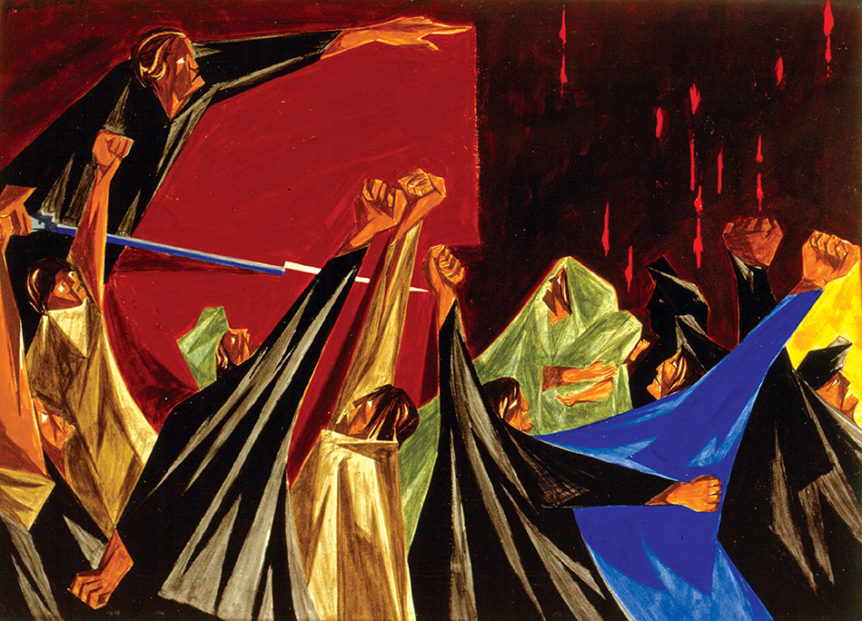Scholars hope to reunite all thirty paintings in Jacob Lawrence’s Struggle series, his epic of early American history. But the whereabouts of several panels is unknown.
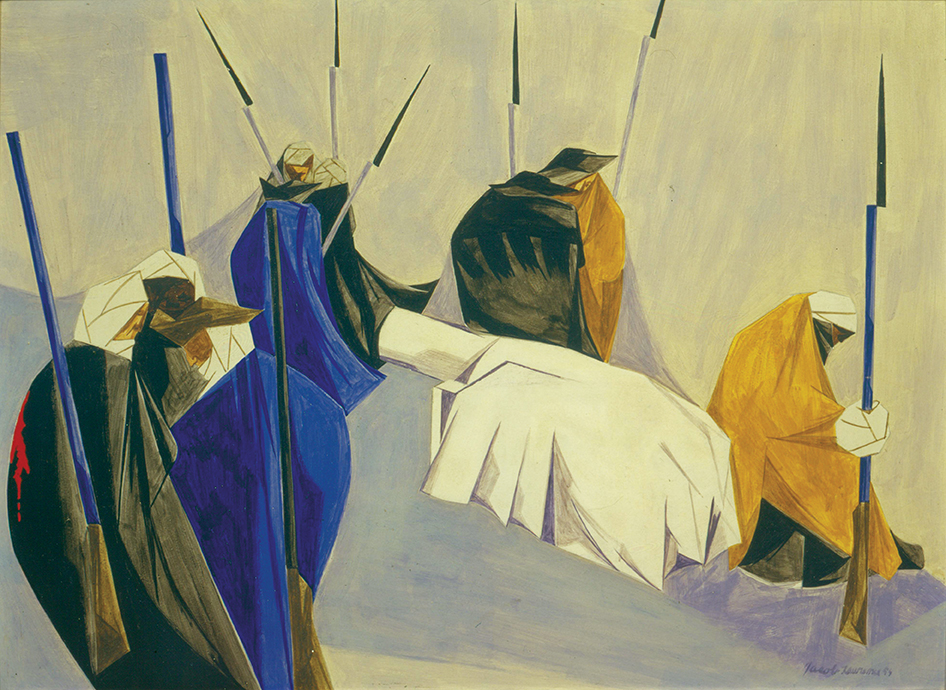
Fig. 1. The summer soldier and the sunshine patriot will, in this crisis, shrink from the service of his country. —Thomas Paine, 1776, panel 7, 1956, of the series Struggle…From the History of the American People by Jacob Lawrence, 1954–1956. Signed and dated “Jacob Lawrence 56” at lower right. Egg tempera on hardboard, 12 by 15 1⁄2 inches. Renee and Chaim Gross Foundation, New York, © Jacob and Gwendolyn Knight Lawrence Foundation, Seattle/Artists Rights Society (ARS), New York.
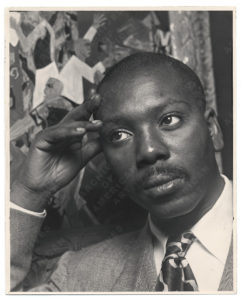
Fig. 2. Jacob Lawrence (1917–2000) in a photograph by Alfredo Valente (1899–1973), 1957. Archives of American Art, Smithsonian Institution, Washington, D. C., Alfredo Valente papers, 1941–1978.
Jacob Lawrence was one of the greatest narrative artists of the twentieth century. By 1938, when he was just twenty-one years old, Lawrence had gained prominence as a painter not only in Harlem, where he lived and worked, but also in the otherwise racially segregated New York art world. His admirers were captivated both by his subject matter and his unique format. He painted biographical narratives of famed African Americans in sweeping series of same-size panels with captions—akin to storyboards for films. As Lawrence saw it, not one but many images were needed to tell “the complete story.”1
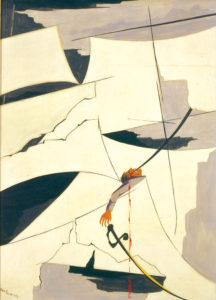
Fig. 3. …If we fail, let us fail like men, and expire together in one common struggle…–Henry Clay, 1813, panel 23 of the Struggle series, 1956. Signed and dated “Jacob Lawrence 56” at lower left. Egg tempera on hardboard, 16 by 12 inches. Collection of Harvey and Harvey-Ann Ross, © Jacob and Gwendolyn Knight Lawrence Foundation, Seattle/Artists Rights Society (ARS), New York.
Seven of Lawrence’s ten narrative series have remained intact.2 One notable exception is his sixty-panel masterwork The Migration of the Negro—painted in 1940 and 1941, and later renamed The Migration Series by the artist—whose ownership is evenly split between the Museum of Modern Art in New York and the Phillips Collection in Washington, D. C. Reunions of the Migration panels have occurred with regularity recently—at MoMA in 2015 and at the Phillips in 2016, and another opens in January at the Seattle Art Museum—bringing with them new scholarly and critical readings of Lawrence’s work. But similar good fortune has eluded another of the artist’s epic narrative cycles. Struggle… From the History of the American People, painted between 1954 and 1956, is composed of thirty panels depicting signal moments in the American Revolution and the early decades of the republic from the perspectives of Founding Fathers, enslaved people, women, and Native Americans. The series has not been seen intact since 1958. What could it mean to our understanding of the art of Jacob Lawrence to bring these paintings together again?
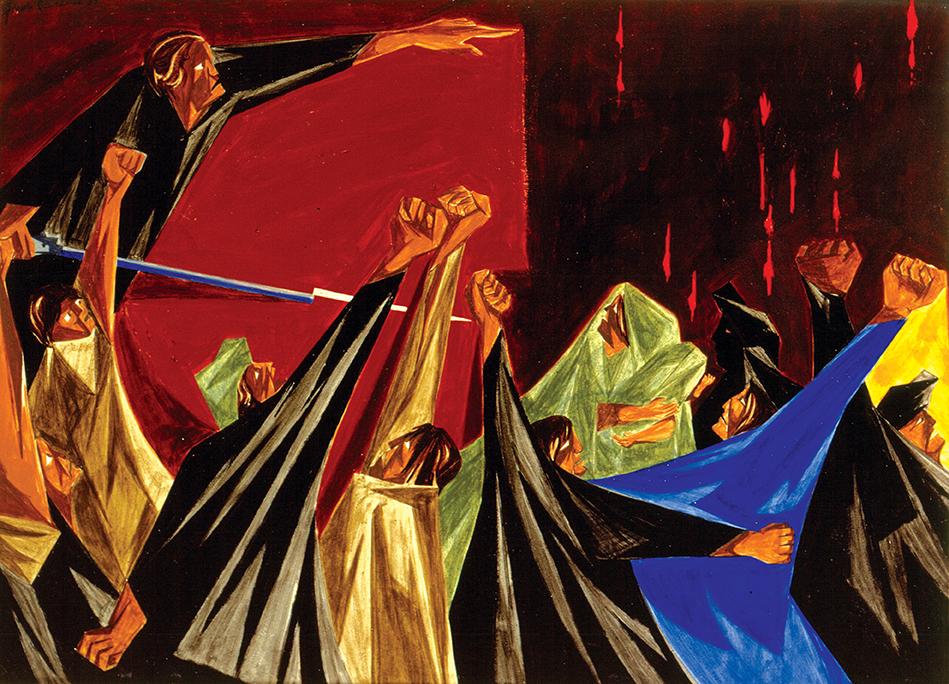
Fig. 4. …Is Life so dear or peace so sweet as to be purchased at the price of chains and slavery? panel 1 of the Struggle series, 1955. Signed and dated “Jacob Lawrence 55” at upper left. Egg tempera on hardboard, 12 by 16 inches. Ross Collection, © Jacob and Gwendolyn Knight Lawrence Foundation, Seattle/Artists Rights Society (ARS), New York.
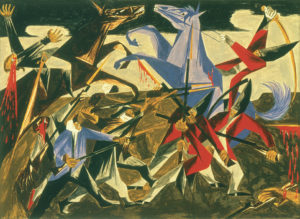
Fig. 5. …Again the rebels rush furiously on our men—a Hessian soldier, panel 8 of the Struggle series, 1954. Signed and dated “Jacob Lawrence 1954” at lower right. Egg tempera on hardboard, 12 by 15 ½ inches. Ross Collection, © Jacob and Gwendolyn Knight Lawrence Foundation, Seattle/Artists Rights Society (ARS), New York.
Recently, an extensive planning process has been launched with the Peabody Essex Museum in Salem, Massachusetts, to exhibit and tour Lawrence’s Struggle… From the History of the American People in its entirety, starting in 2020 at PEM.3 The greatest challenge is this: several of the Struggle panels are missing. In 2000, at the time of the publication of the Jacob Lawrence catalogue raisonné, six of the thirty Struggle series panels could not be located. Of those, two were without photo documentation—we simply don’t know what they look like. Since that time, happily, one panel—depicting the Boston Tea Party—out of the six has been located, leading to the hope that there are others that remain unrecognized as part of this series. Of the twentyfive that are not missing, five are now held in public collections, including the Metropolitan Museum of Art, the Fogg Museum at Harvard, the Cantor Arts Center at Stanford, and the Renee and Chaim Gross Foundation in New York. The others are in private hands.
Beyond reuniting the missing and dispersed works, the proposed reunion of the Struggle series aims to recover content and much needed context through new scholarship.4 Critical discussions surrounding reunions of the Migration series typically revisit topics such as Depression-era Harlem (where Lawrence’s prodigy was nurtured in art workshops), the promotion of his work by philosopher Alain Locke, and the first exhibitions of Lawrence’s work in dealer Edith Halpert’s famed Downtown Gallery—all within the context of events such as the negotiations over the proposed March on Washington in 1941. Lawrence’s Struggle narrative from the 1950s points to the circumstances surrounding his mature practice in the hands of a new dealer, Charles Alan, amid the McCarthy hearings, the birth of the modern Civil Rights Movement, and the Supreme Court’s decision regarding segregation in Brown vs. Board of Education.
What we know about Lawrence’s original intention for the Struggle series comes from the texts of two grant applications written in 1954.5 Apparently the idea for this history series came to the artist around 1949, not long after the publication of John Hope Franklin’s From Slavery to Freedom: A History of American Negroes in 1947, and he developed his plan by assembling a file of three hundred clippings that are in what is now the New York Public Library’s Schomburg Center for Research in Black Culture. At some point in the next four years, Lawrence changed the project to a reinterpretation of iconic events in American history. The pivotal moments Lawrence chose to depict correspond with the periods, or time frames, of American history outlined in general texts such as Charles and Mary Beard’s History of the United States (1921). Lawrence’s unsuccessful application to the Guggenheim Foundation outlined an epic sweep from the founding of Jamestown to the World War I armistice, told in eighty panels. His successful application to the Chapelbrook Foundation in December 1954 reduced the scope to sixty panels, starting with the American Revolution and stopping with, as he wrote, “the sailing of the American Fleet around the world in 1908.” Much as he had in his application to the Julius Rosenwald Fund to finance the Migration series, Lawrence estimated the entire project would take eighteen months to complete.6 Between 1954 and 1956, contrary to the method outlined in his grant applications—and certainly in contrast to his practice with the Migration series, whose sixty panels were numbered and painted all at once, color by color—the Struggle series was not painted chronologically in order of events or subjects but, rather, episodically and intermittently over the course of two and a half years. Judging from the signatures and dates on the front of the sixteen panels completed in 1954 and 1955, Lawrence lingered on scenes from the Revolution. In 1956 he turned his attention to events of the early nation, westward expansion, and the War of 1812. The process was ruminative. As Lawrence described it to writer and critic Selden Rodman (1909–2002) in 1956: “The history of the United States fascinates me. Right now, I’m reading in it, looking at any episode that suggests a symbol of struggle.”7
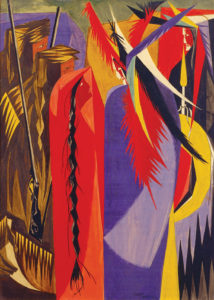
Fig. 9. In all your intercourse with the natives, treat them in the most friendly and conciliatory manner which their own conduct will admit–Jefferson to Lewis & Clark, 1803, panel 18 of the Struggle series, 1956. Signed and dated “Jacob Lawrence 56” at lower center. Egg tempera on hardboard, 16 by 12 inches. Ross Collection, © Jacob and Gwendolyn Knight Lawrence Foundation, Seattle/Artists Rights Society (ARS), New York.
The scholar Richard J. Powell has pointed out that in the Struggle narrative Lawrence explores a new perceptual and psychological experience at mid-century that requires a different type of reading—indeed a new way of seeing abstraction in Lawrence’s work.8 Lawrence’s Struggle series discarded the bold figure-ground contrasts of the social realists of the 1930s. His new protagonists are not easily identifiable, but rather caught up in a fractured web of dynamic space. Instead of a narrative progression, the succession of bloody, unresolved confrontations of the Struggle series are punctuated by images of idle cannon, suggesting moments of reflection upon past acts of heroism and sacrifice amid bitter ironies. Also, there is a new and radically disjointed correlation between the subjects of the images and Lawrence’s captions, which feature excerpts from famous speeches as well as reports, letters, and petitions from anonymous soldiers and enslaved people. For example, in panel 23 (Fig. 3), the depiction of a single wounded sailor entangled among the fallen masts and sails in the Battle of Lake Erie in 1813 (an American victory) is accompanied by Henry Clay’s 1813 appeal to Congress for solidarity and continued funding support for the war (which was not going well). Clay’s rhetoric climaxed with the phrase, “if we fail, let us fail like men… and expire together in one common struggle.”
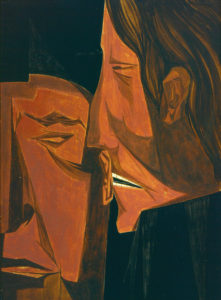
Fig. 10. 120.9.14.286.9.33-ton 290.9.27 be at 153.9.28.110.8.17.255.9.29 evening 178.9.8–Informer’s coded message, panel 11 of the Struggle series, 1955. Signed and dated “Jacob Lawrence 55” at upper right. Egg tempera on hardboard, 16 by 12 inches. Iris and B. Gerald Cantor Center for Visual Arts, Stanford Univer- sity, © Jacob and Gwendolyn Knight Lawrence Foundation, Seattle/Artists Rights Society (ARS), New York.
For a contemporary explanation of the role of the captions, we turn again to Rodman’s 1956 interview with Lawrence, where it was reported that “Jay Leider [sic], author of The Melville Log, is working on a text and they hope to bring out together a printed version of the series.”9 Leyda’s Melville Log: A Documentary Life of Herman Melville 1819–1891 (1951) is a compilation of primary source materials that allows a reader to devise his own approach to Herman Melville’s biography. Similarly, the juxtapositions in Lawrence’s Struggle series seem to invite the viewer to find the prosodic or temporal connections between the images of historical protagonists and the voices from the texts. For example, consider panel 8 (Fig. 5), where the image of clashing soldiers in the Battle of Bennington of 1777 (another American victory) is accompanied by a caption taken from an account written by a Hessian soldier on the opposing side. Here the viewer is left to ponder the fate of the Hessians, as well as the fate of the African Americans fighting alongside the Green Mountain Boys, and determine the connection between image and text. Ironically, after the war, the Hessian mercenaries would be granted citizenship long before the descendants of African Americans who fought and died in the American Revolution.
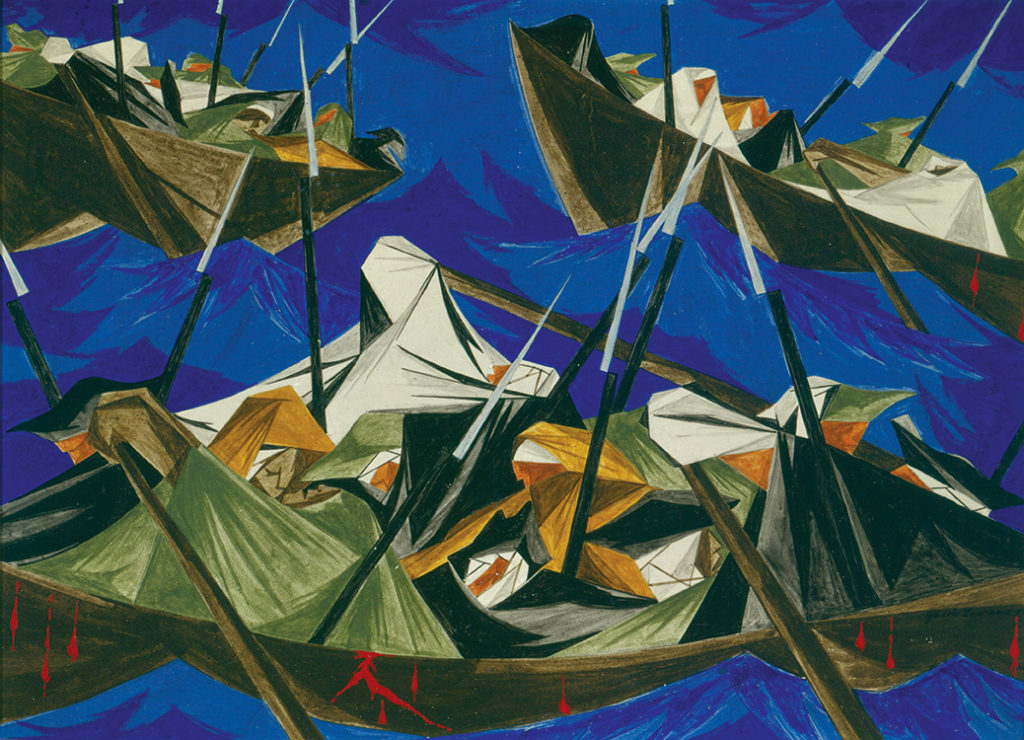
Fig. 11. We crossed the River at McKonkey’s Ferry 9 miles above Trenton…the night was excessively severe…which the men bore without the least murmur…—Tench Tilghman, 27 December 1776, panel 10 of the Struggle series, 1954. Signed and dated “Jacob Lawrence 54” at lower right. Egg tempera on hardboard, 12 by 16 inches. Metropolitan Museum of Art, © Jacob and Gwendolyn Knight Lawrence Foundation, Seattle/ Artists Rights Society (ARS), New York.
Sadly, the Struggle book project was never realized. If the resolution of Lawrence’s American narrative was open ended, when and how was it considered complete? After painting thirty panels, Lawrence exhibited his new series in December 1956. Once these paintings left his studio, he never returned to the series. Though an exhibition brochure assigned the panels numbers 1 through 30, even the order or sequence was far from clear, since the gallery numbers do not correspond to Lawrence’s pencil notations on the backs of the panels. According to gallery records, Charles Alan attempted to market the series to MoMA through Alfred H. Barr Jr. and to collectors affiliated with museums such as Mary French Rockefeller and department store magnate Stanley Marcus. In the end, the Struggle series was sold to collector William Meyers of Long Island. The sales contract signed on January 8, 1959, specified that Lawrence retained reproduction rights and that, upon request, the paintings were to be made available to him.10 Since no stipulation was made about keeping the series together, Meyers was free to sell off individual panels. Though Meyers’s papers have yet to be located, based on the provenance and exhibition histories of individual Struggle series panels listed in the catalogue raisonné, the dispersal seems to have begun soon after his purchase and to have continued for the remainder of the 1960s.11
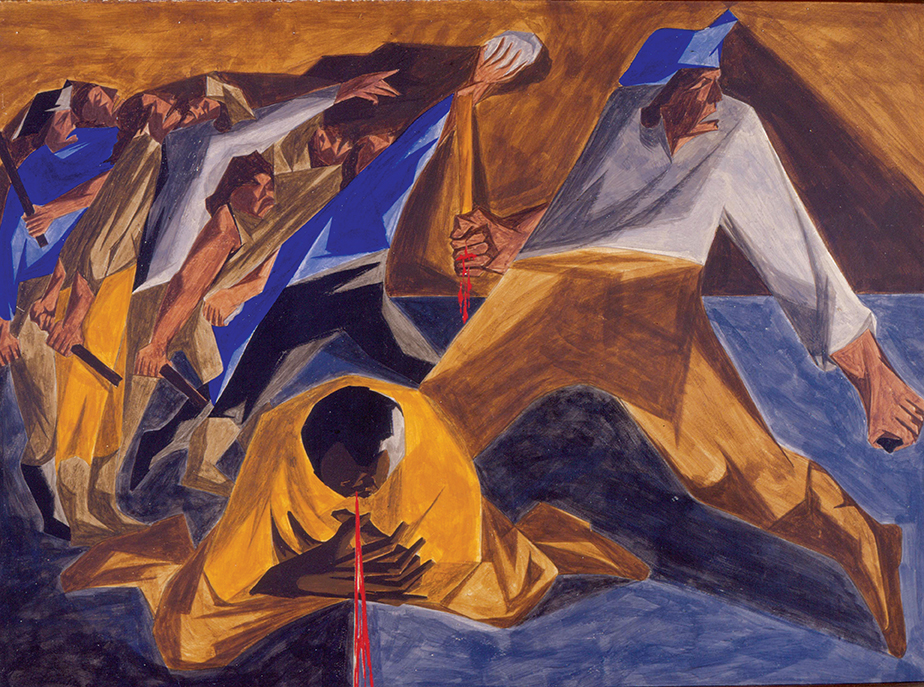
Fig. 12. Massacre in Boston, panel 2 of the Struggle series, 1955. Signed and dated “Jacob Lawrence 55” at lower left. Egg tempera on hardboard, 12 by 16 inches. Ross Collection, © Jacob and Gwendolyn Knight Lawrence Foundation, Seattle/Artists Rights Society (ARS), New York.
Largely due to its dispersal, Lawrence’s revolutionary Struggle series remains under-studied, the full import of its content, in effect, suppressed. We would do well to recall fully Lawrence’s depictions of the unseen and underrepresented contributors to American history. We would do well to remember that Lawrence chose to depict the fallen Crispus Attucks in the 1770 Boston Massacre (panel 2) even as images of Emmett Till’s mutilated body were published in 1955. In 1958, when the Struggle panels were last seen all together, Lawrence described the situation to Jay Leyda as follows: “the big issues at this time being to have or not to have integration in the public schools…and trying to reach the moon. [B]oth seem to be a little time off. I think the moon problem will be solved before the one on integration.”12 By reuniting Lawrence’s Struggle series, we can continue to explore a great artist’s understanding of America’s long-term project to build a more perfect union for all its citizens.
ELIZABETH HUTTON TURNER is University Professor of Modern Art at the University of Virginia in Charlottesville.
1 Jacob Lawrence interview, Elizabeth Hutton Turner, Seattle, Washington, October 3, 1992, transcript in the Phillips Collection Archives, Washington, D. C. For criteria and definitions of the series format in Lawrence’s oeuvre, see “Notes to the Catalogue,” in Over the Line: The Art and Life of Jacob Lawrence, ed. Peter T. Nesbett and Michelle DuBois (University of Washington Press/Jacob Lawrence Catalogue Raisonné Project, Seattle, 2000), pp. 13–14. 2 The catalogue raisonné (see n. 1) identifies ten narrative series in Lawrence’s oeuvre: The Life of Toussaint L’Ouverture (1938), The Life of Frederick Douglass (1939), The Life of Harriet Tubman (1940), The Migration of the Negro (1941—which Lawrence renamed The Migration Series in 1993, while revising the caption/titles of most panels), The Life of John Brown (1941), War (1946–47), Struggle… From the History of the American People (1954–1956), Harriet and the Promised Land (1968), George Washington Bush (1973), and Eight Studies for the Book of Genesis (1989). Of those ten, three are either divided or dispersed: The Migration Series, Struggle… From the History of the American People, and Harriet and the Promised Land. 3 I launched this planning process in 2015 with study displays of the Struggle series panels from the collection of Harvey and Harvey-Ann Ross at the Phillips Collection (January–August 2015) and at the Fralin Museum of Art at the University of Virginia (September 2015–June 2016). I will serve as guest curator, in collaboration with Austen Barron Bailly, the George Putnam Curator of American Art at the Peabody Essex Museum. PEM and I will work together to locate the missing panels and organize the exhibition of the entire Struggle series.4 To this end, two interdisciplinary symposiums have already been hosted: at the Phillips Collection on February 27, 2015, with Aaron Bryant, Spencer Crew, David Driskell, and Elsa Smithgall; and at the University of Virginia on April 15, 2016, with Sandy Alexandre, Shilpa S. Dave, Theresa M. Davis, David C. Driskell, Carmenita Higginbotham, Patricia Hills, M. Jordan Love, John Ott, and Lynn M. Sanders. 5 See Jacob Lawrence to John Simon Guggenheim Memorial Foundation, January 28, 1954, p. 1, John Simon Guggenheim Memorial Foundation, New York; and Chapelbrook application, Alan Gallery records, Archives of American Art, microfilm reel 1380, frames 1169–70. I am grateful to Patricia Hills for making a photocopy of Lawrence’s Guggenheim application available to me. See also Patricia Hills, “The Paintings of the Protest Years, 1955–70,” in Painting Harlem Modern: The Art of Jacob Lawrence (University of California Press, Berkeley, 2009), p. 232. 6 Jacob Lawrence, “Plan of Work,” p. 2, Julius Rosenwald Fund Application, Rosenwald Fund Collection, Special Collections, Fisk University Library, Nashville, Tennessee. I am grateful to scholar Diane Tepfer for making available her photocopies of Lawrence’s Rosenwald Foundation funding application to the staff of the Phillips Collection during the planning process for the 1993 reunion of The Migration Series. 7 Selden Rodman, “Jacob Lawrence,” in Conversations with Artists (Devin-Adair Co., New York, 1957), p. 205. 8 Richard Powell, “Harmonizer of Chaos,” in Over the Line: The Art and Life of Jacob Lawrence, pp. 156–162. 10 Rodman, “Jacob Lawrence,” pp. 204–205. 10 Alan Gallery records, microfilm reel 1383, frames 0514, 0560, 0786, 805 and reel 1380, frames 1212–1213. I want to thank my student Shannah Rose for bringing this information to my attention. Shannah delved deeply into the Charles Alan Gallery records. See Shannah Margaret Rose, “Rhetorics of Freedom & Realities of Revolt at Mid-Century: Jacob Lawrence’s Struggle…From the History of the American People, 1954–56″ (B.A. honors thesis, University of Virginia, 2016), pp. 31–32. 11 Over the Line: The Art and Life of Jacob Lawrence, pp. 130–138. 12 Jacob Lawrence to Jay Leyda [c. 1958], folder 21, box 5, Jay and Si-Lan Chen Leyda Papers, Tamiment Library & Robert F. Wagner Labor Archives, Elmer Holmes Bobst Library, New York University.

